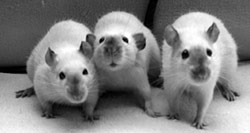In the Name of Science
Rats Prefer Sweetened Water to Cocaine
Nov 2008
Citation: Erowid. "Rats Prefer Sweetened Water to Cocaine." Erowid Extracts. Nov 2008;15:19.

|
Researchers have previously found that providing rats with sweetened water significantly reduced their voluntary cocaine intake,3 and a recent study has reported that rats overwhelmingly prefer water sweetened with saccharin or sucrose over cocaine.4 When presented with an either/or choice eight times a day, 94% of test rats selected the non-caloric sweetener saccharin over a "behaviorally effective" dose of cocaine (0.25 mg, i.v.). While it took the rats eleven days to develop a statistically reliable preference for selecting cocaine over nothing, it took only two days to develop a statistically reliable preference for saccharin over cocaine.4
According to the researchers, "the preference for saccharin sweet taste was not surmountable by increasing doses of cocaine and was observed despite either cocaine intoxication, sensitization or intake escalation--the latter being a hallmark of drug addiction". Pointing out apparently contradictory findings from previous primate studies that offered solid pellets instead of sweetened liquids, the researchers speculate that important differences may exist between the research methods or could be a result of inter-species differences between rodents and primates.
References #
- Schenk S, Lacelle G, Gorman K, Amit Z. "Cocaine self-administration in rats influenced by environmental conditions: Implications for the etiology of drug abuse". Neuroscience Letters. 1987;81(1-2):227-31.
- Carroll ME, France CP, Meisch RA. "Food deprivation increases oral and intravenous drug intake in rats". Science. Jul 1979; 205(4403):319-21.
- Carroll ME, Lac ST, Nygaard SL. "A concurrently available nondrug reinforcer prevents the acquisition or decreases the maintenance of cocaine-reinforced behavior". Psychopharmacology. 1989;97(1):23-9.
- Lenoir M, Serre F, Cantin L, Ahmed SH. "Intense Sweetness Surpasses Cocaine Reward". PLoS ONE. 2007;2(8):1-10.


